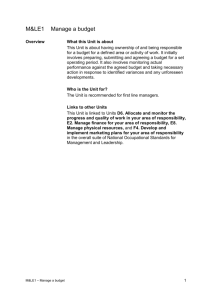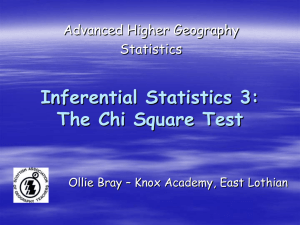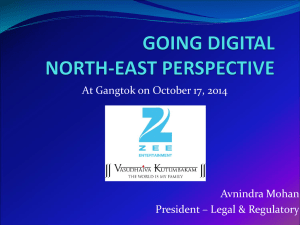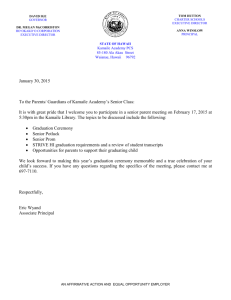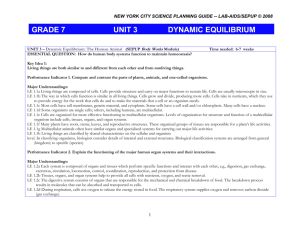Program Review – 2009-2010 Liberal Arts and Sciences and Childhood Education
advertisement
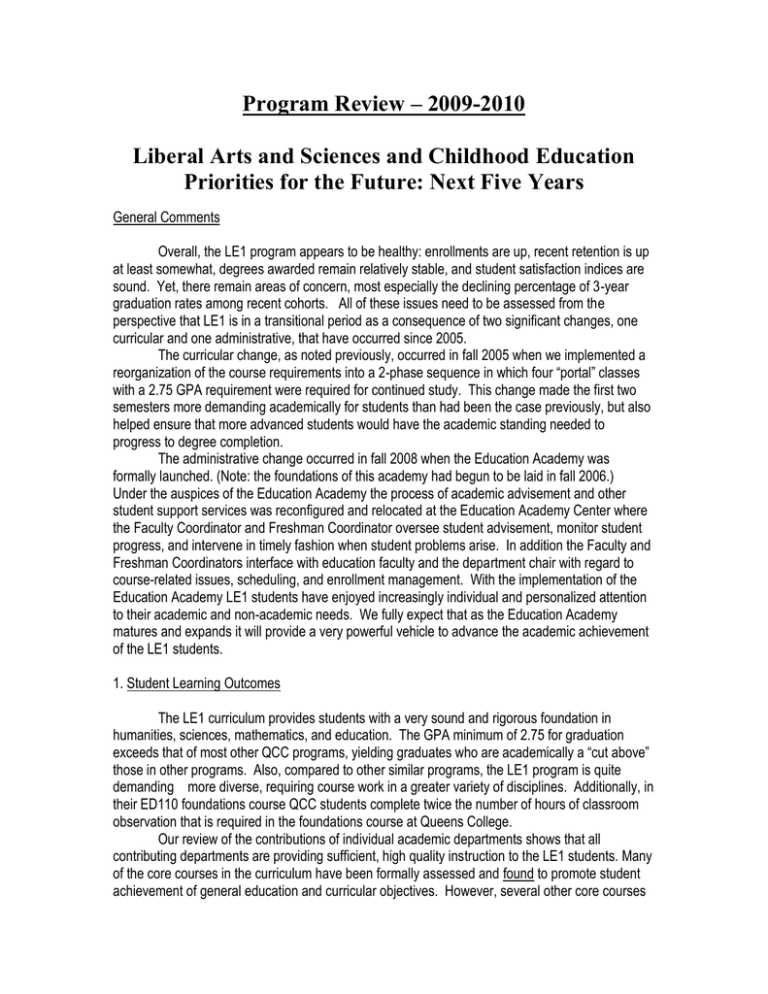
Program Review – 2009-2010 Liberal Arts and Sciences and Childhood Education Priorities for the Future: Next Five Years General Comments Overall, the LE1 program appears to be healthy: enrollments are up, recent retention is up at least somewhat, degrees awarded remain relatively stable, and student satisfaction indices are sound. Yet, there remain areas of concern, most especially the declining percentage of 3-year graduation rates among recent cohorts. All of these issues need to be assessed from the perspective that LE1 is in a transitional period as a consequence of two significant changes, one curricular and one administrative, that have occurred since 2005. The curricular change, as noted previously, occurred in fall 2005 when we implemented a reorganization of the course requirements into a 2-phase sequence in which four “portal” classes with a 2.75 GPA requirement were required for continued study. This change made the first two semesters more demanding academically for students than had been the case previously, but also helped ensure that more advanced students would have the academic standing needed to progress to degree completion. The administrative change occurred in fall 2008 when the Education Academy was formally launched. (Note: the foundations of this academy had begun to be laid in fall 2006.) Under the auspices of the Education Academy the process of academic advisement and other student support services was reconfigured and relocated at the Education Academy Center where the Faculty Coordinator and Freshman Coordinator oversee student advisement, monitor student progress, and intervene in timely fashion when student problems arise. In addition the Faculty and Freshman Coordinators interface with education faculty and the department chair with regard to course-related issues, scheduling, and enrollment management. With the implementation of the Education Academy LE1 students have enjoyed increasingly individual and personalized attention to their academic and non-academic needs. We fully expect that as the Education Academy matures and expands it will provide a very powerful vehicle to advance the academic achievement of the LE1 students. 1. Student Learning Outcomes The LE1 curriculum provides students with a very sound and rigorous foundation in humanities, sciences, mathematics, and education. The GPA minimum of 2.75 for graduation exceeds that of most other QCC programs, yielding graduates who are academically a “cut above” those in other programs. Also, compared to other similar programs, the LE1 program is quite demanding more diverse, requiring course work in a greater variety of disciplines. Additionally, in their ED110 foundations course QCC students complete twice the number of hours of classroom observation that is required in the foundations course at Queens College. Our review of the contributions of individual academic departments shows that all contributing departments are providing sufficient, high quality instruction to the LE1 students. Many of the core courses in the curriculum have been formally assessed and found to promote student achievement of general education and curricular objectives. However, several other core courses have not been assessed to date with regard to general education and curricular objectives; consequently, for those courses a gap in our knowledge about learning outcomes remains. Although the 3-year graduation rate appears to be in decline, the 6-year graduation rates for the 2001-03 Fall cohorts indicates that the LE1 program rate exceeds the overall QCC rate by 3 percent. This comparison gives us confidence that the LE1 students are persisting and eventually graduating at an above average rate, albeit they are taking longer to do so. After graduating 85% of LE1 students transfer to Queens College, and eventually nearly 40% receive a Queens College bachelor’s degree. The disturbing downward trend in CPE passing rates for LE1 students strongly indicates a need to enhance the readiness of those students for the demands of the exam in the hope of increasing 3-year graduation rates for the program. Recommendations: Increase the number of courses in the curriculum that undergo assessment. Improve methodologies for conducting course assessment as pertains to general education objectives. Increase the number of faculty participating in course assessment activities. Evaluate the impact of learning communities on student learning outcomes. Evaluate the impact of writing intensive pedagogy on student learning outcomes. Explore implementation of early interventions (e.g., peer mentoring) for high-risk lower- and upper-freshmen to improve retention. Initiate CPE preparation workshops for LE1 students. Examine strategies for incorporating CPE-relevant skills development into core courses in the LE1 program. Initiate curriculum-specific assessment of effectiveness of academic and other support services for LE1 students. 2. Curriculum Development Since a major overhaul of the program in 2000, the requirements of the LE1 program have not changed dramatically. While some minor changes have occurred in the way of minimum grades for specific courses, the core courses have remained much the same. Nearly all the minor changes made since 2000 have been reactive, rather than intended changes. It has been necessary for QCC to adjust certain requirements to accommodate curricular changes at Queens College, especially by their EECE department. Any significant future curriculum development will require more ongoing collaboration and communication with Queens College. The major curricular change was the adoption of the two-phase sequence of courses, implemented in 2005. Although this change made the program more challenging academically for students during their UF semester and might be partly responsible for the reduced 3-year graduation rates, it did succeed in winnowing out underperforming students and helping them to obviate the unfortunate consequences that many would have experienced by persisting too long without hope of achieving the 2.75 GPA minimum. A significant development in the program, gradually evolving over the past five years, is the inclusion of learning communities as vehicles for delivering high impact, cornerstone course experiences in the freshman year. Each semester 2 or 3 of the ED110 education “foundations” course are linked in learning communities with EN101 classes, thus providing students with a “2 for 1” cornerstone course combination. In addition, each semester another learning community linking ED110 with Physics 101 is offered; this has proven beneficial in helping students succeed in this required lab science. While appreciating the common sense wisdom of the “If it ain’t broke, don’t fix it” principle, it might be beneficial to revisit the LE1 curriculum to make it even better. Compared to other associate degree programs in education, in the LE1 program psychology courses are conspicuous in their absence. Given that teacher education students will be working with children, it seems quite reasonable that they should be required to take psychology and child development as part of their program of study. In addition, another area of deficiency is seen in the stinginess of education courses. The LE1 curriculum contains only two education-specific courses, ED110 and MU261, for a total of 7 credits which is fewer than in any other CUNY associates degree program in education. Another area for program development involves capstone experiences. The QCC Strategic Plan mandates that every academic program will identify one or more capstone experiences for students. These capstone experiences might take the form of specific courses, service learning, ePortfolio, and others. The education faculty has been exploring the use of ePortfolio as a capstone experience for LE1 students, and while it is a promising initiative, it is unlikely that all LE1 students will want to or be able to take advantage of it. Thus, other capstone options must be considered, e.g., a Special Topics in Education course whose focus could change depending on current issues in education and on faculty and student interests. Recommendations: Explore more options for capstone experiences, such as a capstone Special Topics course. Explore more options for additional learning communities. Explore adding psychology course work to the curriculum. Review current suggested course sequence for possible restructuring to facilitate student success early in the program. Increase collaboration and communication with education department at Queens College. Ensure that students are permitted to graduate based on the curricular requirements at the time of their matriculation. Explore articulations with other public and private colleges. 3. Faculty Recruitment and Development The current education faculty at QCC is a small, but talented group of highly credentialed professionals who are dedicated to the success of their students. At present the education faculty, combined full- and part-time, is sufficient to meet the needs of the LE1 program. However, should the enrollment continue to grow at its recent pace, then additional part-time and ultimately perhaps even full-time faculty will be required. The education faculty is sufficiently diverse except with regard to gender; over the past five years not a single education course has been taught by a male faculty member. While the LE1 students are predominantly (i.e., 90%) female, the male minority might benefit by having access to a male faculty member who serves as mentor and role model. As regards the education program, the biggest challenge to faculty development is getting new adjunct faculty trained in Writing Intensive pedagogy in a timely fashion. LE1 students are required to take two classes as WI: ED110 Contemporary Education and SS610 Philosophy, and so, it is important that faculty teaching those courses receive WI training. Unfortunately, given their other time commitments, new adjunct faculty often cannot attend the requisite workshops to become WI certified. In addition, adjunct faculty often do not have the opportunity to participate in other development initiatives, such as workshops on learning communities. On the whole, however, full- and part-time faculty who teach courses in the LE1 program have many opportunities to participate in faculty development activities through the offerings of CETL which gives numerous workshops on many topics throughout the academic year. Recommendations: Recruit male education adjunct faculty. Explore alternative means of providing WI certification to education and philosophy faculty. Encourage greater faculty participation in professional development activities and the use of innovative pedagogy. 4. Equipment and Facilities With the formal launch of the Education Academy in fall 2008 the QCC administration provided a generous space to house the academy, its Freshman Coordinator and his administrative assistant. Some computer workstations were added and along with other furnishings the center has been transformed into an active meeting place for students, academy staff, and education faculty. The location of the academy center is ideal, as it is situated across from the Department of Social Sciences office and is in close proximity to the offices of the education faculty and the faculty coordinator for the academy. While the addition of the Education Academy Center has been a great boon for the education students, the lack of fixed instructional technology in most classrooms continues to be a problem. It is sadly ironic that our education students are not provided with sufficient experience learning from and working with instructional technology, when they will be expected to use it in their work as teachers. Recommendations: The college should provide more computer labs and Smart Rooms with fixed instructional technology. Students should be provided with more opportunities to work with instructional technology. Students should be provided with support staff to guide student e-Portfolio work. The college should expand the Education Academy support staff services to follow the student through graduation. Conclusions We find that, overall, the LE1 program is in sound shape, with its strengths far exceeding its weaknesses. The high quality of instruction and academic and other support services promotes the success of the students. As the Education Academy matures and evolves, a more thorough and effective integration of academic and nonacademic service delivery will further enhance student success. It is our hope and expectation that through the collaborative efforts of the faculty, staff, and students, the Education Academy will help address and offset some of the problems regarding student retention and progress toward degree completion. We believe that in the Academy we have the institutional vehicle by which some of the weaknesses in the program can be corrected.
